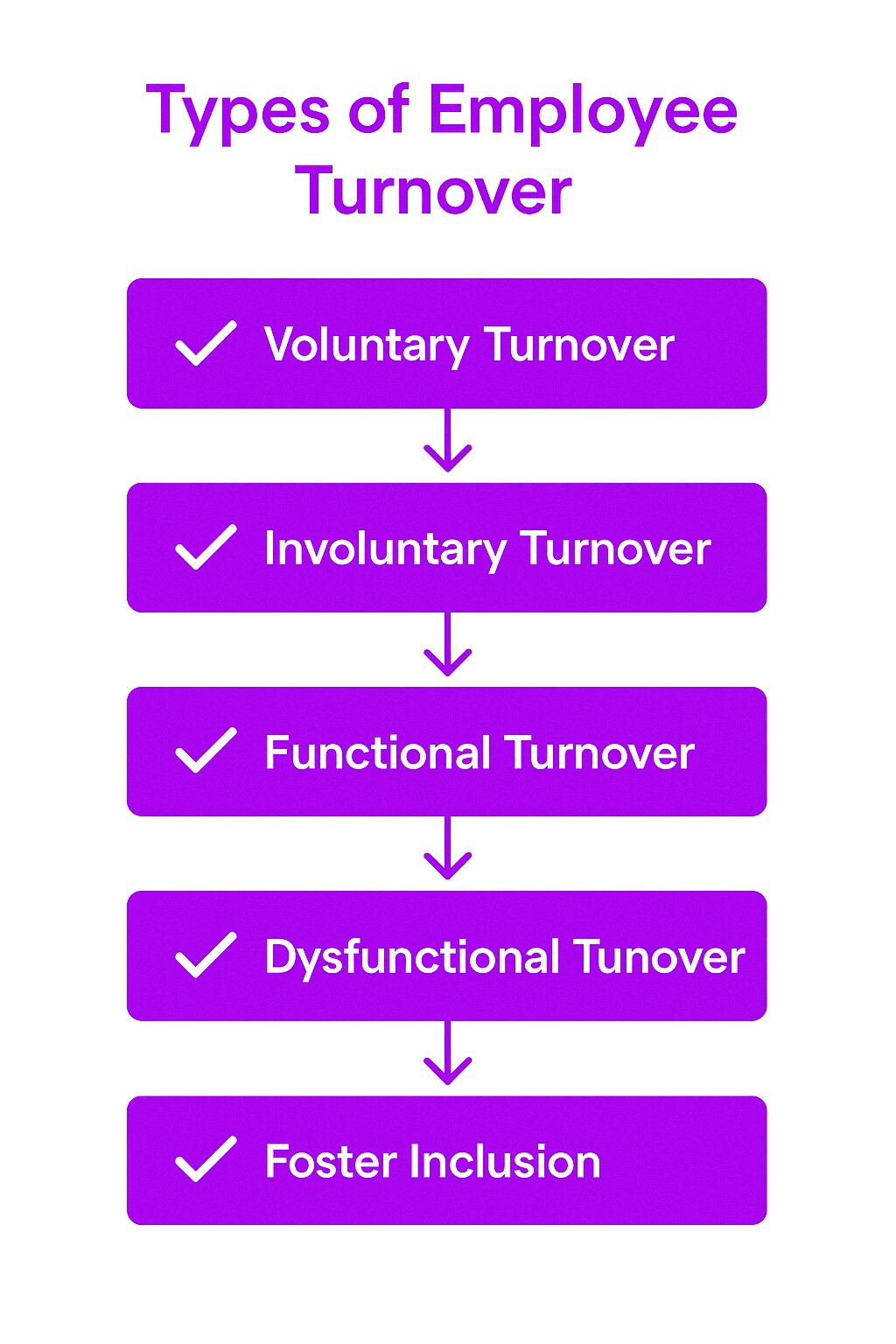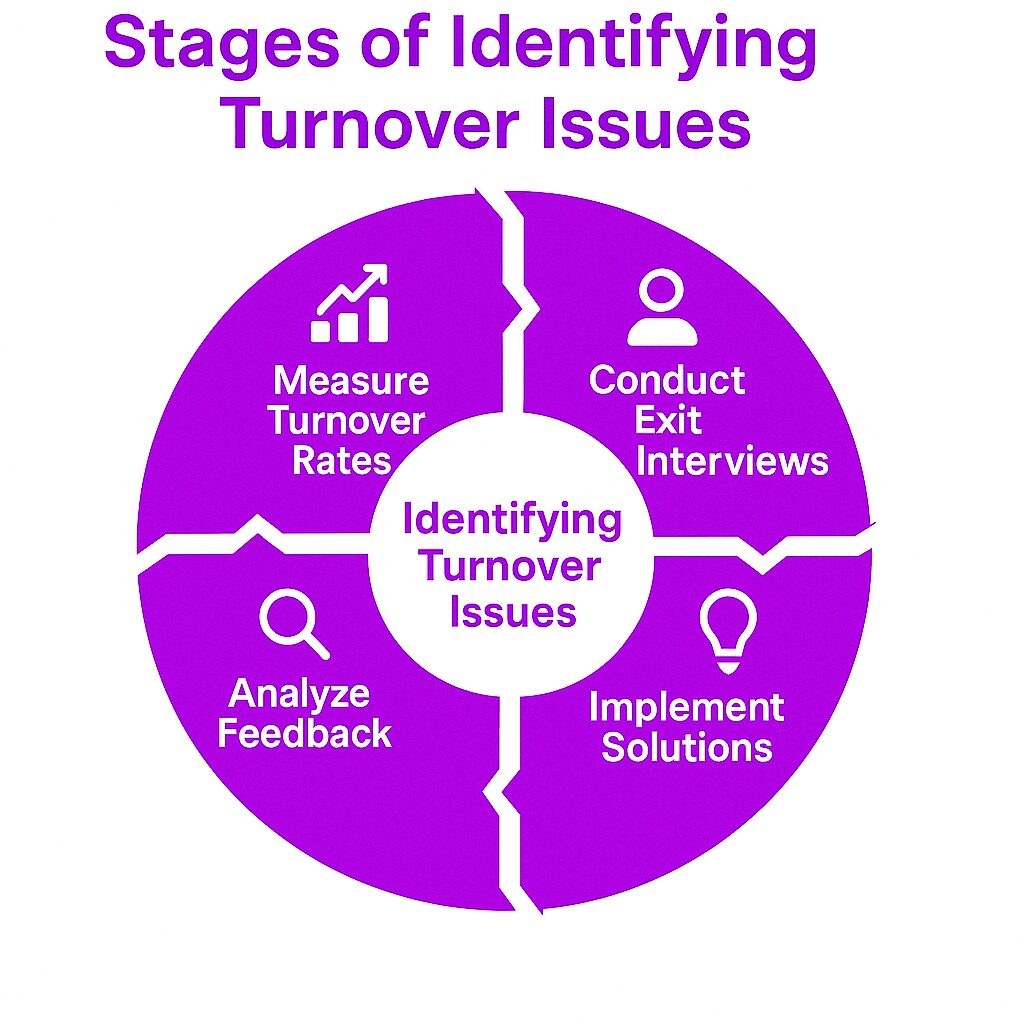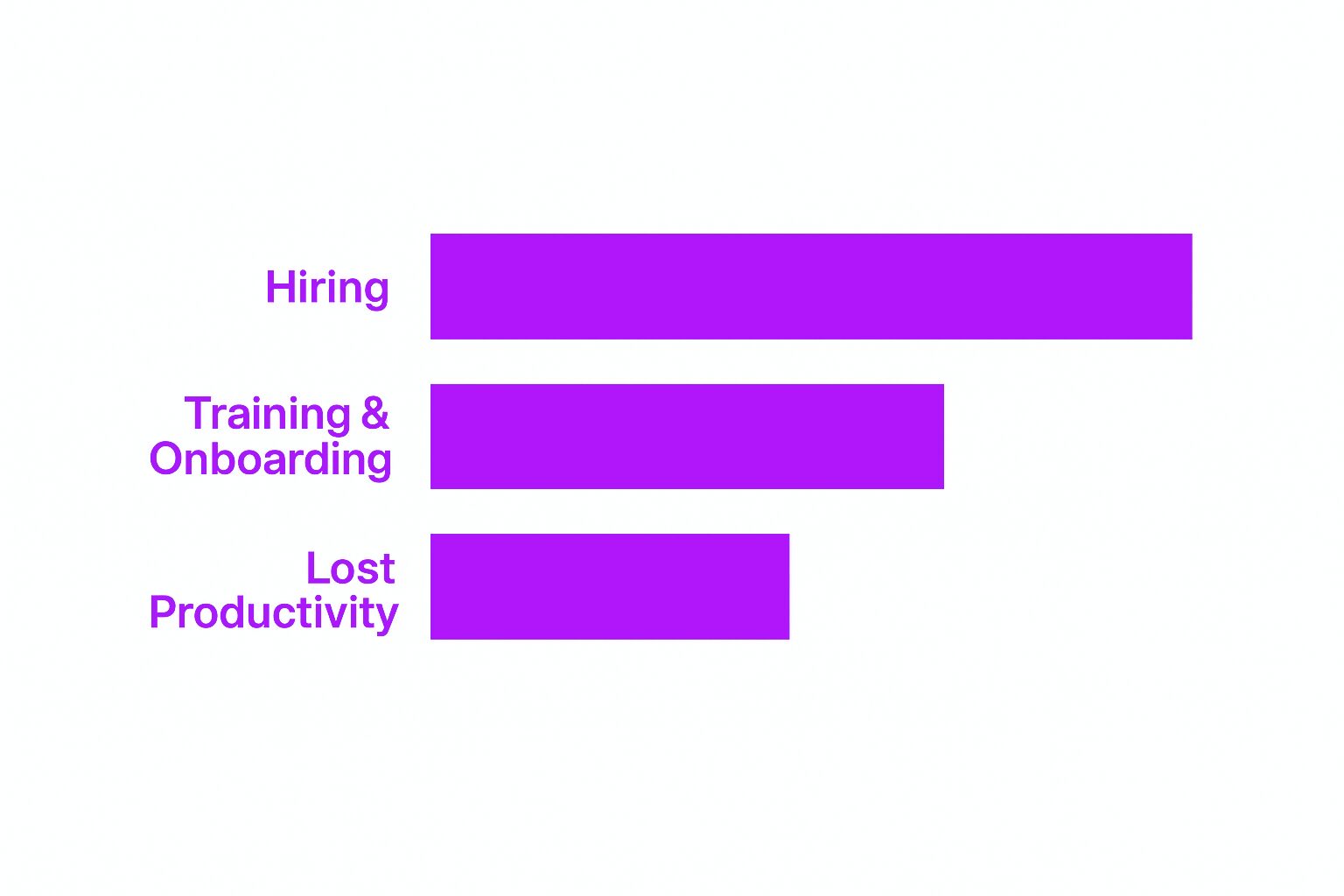What is Employee Turnover?
Employee turnover refers to the number of employees who leave an organization over a specific period. It is a key metric used to measure workforce stability and employee retention. Organizations track turnover rates to assess the effectiveness of their employee engagement, hiring, and retention strategies. According to industry standards like the US Bureau of Labor Statistics, turnover can be categorized into voluntary and involuntary turnover, highlighting their significance in workforce analysis.
Turnover is classified into different types:
-
Voluntary Turnover: Employees resign due to better job opportunities, dissatisfaction, or personal reasons.
-
Involuntary Turnover: Employees are dismissed due to poor performance, company downsizing, or restructuring.
-
Functional Turnover: When an underperforming employee leaves, benefiting the company.
-
Dysfunctional Turnover: When high-performing employees leave, causing a loss of valuable talent.
Types of Employee Turnover
Employee turnover can be classified into different types, each with its own characteristics and implications for the organization.
Why Employee Turnover Matters
Employee turnover rates affect more than just staffing levels. It influences productivity, team morale, and a company’s ability to attract and retain talent. High turnover rates can indicate issues with company culture, compensation, or leadership.
The Impact of High Employee Turnover
-
Increased Hiring Costs: Recruiting, interviewing, and training replacements require time and resources.
-
Productivity Loss: New employees take time to reach full efficiency.
-
Decreased Morale: Employees who see colleagues frequently leaving may feel insecure about their own jobs.
-
Loss of Institutional Knowledge: Experienced employees leaving can disrupt workflows and processes.
Causes of Employee Turnover
Understanding the reasons behind employee departures helps businesses develop strategies to retain talent. Common causes include:
It is crucial to differentiate between existing employees and new hires when calculating the employee turnover rate to accurately reflect the organization’s turnover dynamics.
Poor Compensation and Benefits
Employees expect to be paid fairly for their work. Companies that offer below-market salaries or weak benefits packages risk losing employees to competitors who provide better compensation. Assessing the annual turnover rate can help organizations understand how compensation impacts employee retention.
Limited Career Growth
Lack of opportunities for advancement leads employees to seek roles elsewhere. Employees want to know they have a future within a company.
Poor Work-Life Balance
Employees facing excessive workloads, rigid schedules, or unrealistic expectations often experience burnout, prompting them to leave.
Toxic Workplace Culture
Unhealthy work environments marked by lack of communication, favoritism, or micromanagement contribute to dissatisfaction and turnover.
Ineffective Leadership
Managers who fail to support, mentor, or recognize employees create disengagement. Employees often leave because of poor management rather than dissatisfaction with the job itself.
Better Job Offers
Employees with highly sought-after skills will be recruited by competitors offering better pay, perks, and career advancement opportunities.
Monitoring the monthly employee turnover rate can help identify how frequently these job offers impact overall retention and workforce stability.
Undesirable Turnover
Undesirable turnover refers to the departure of high-performing employees who are valuable to the organization. This type of turnover can be particularly costly and detrimental to the organization’s productivity and morale. When top talent leaves, it often results in a significant loss of institutional knowledge and disrupts team dynamics. Factors contributing to undesirable turnover include poor management, lack of opportunities for growth and development, and inadequate compensation and benefits. Addressing these issues is crucial for maintaining a stable and effective workforce. Undesirable turnover can include both voluntary and involuntary turnover, depending on the circumstances.
Identifying Turnover Issues
Identifying turnover issues is crucial for organizations to address the root causes of employee turnover and implement effective retention strategies. By understanding why employees leave, companies can take proactive steps to improve employee retention and create a more stable workforce.
Measuring Turnover Rates
Measuring turnover rates is essential to understand the scope of the problem and identify trends and patterns. Organizations can calculate their monthly, quarterly, or annual turnover rates using the following formula:
[ text{Turnover Rate} = left( frac{text{Number of Employees Who Left}}{text{Average Number of Employees}} right) times 100 ]
This formula provides a clear picture of the number of employees leaving the organization and helps identify areas for improvement. Regularly tracking turnover rates allows companies to spot potential issues early and take corrective action to reduce employee turnover.
Conducting Exit Interviews
Conducting exit interviews is an effective way to gather information about why employees are leaving the organization. Exit interviews can provide valuable insights into the reasons behind turnover, such as poor management, lack of opportunities for growth, or unsatisfactory working conditions. By understanding these factors, organizations can make data-driven decisions and implement changes to improve employee retention. Exit interviews also demonstrate to departing employees that their feedback is valued, which can help maintain a positive relationship and potentially lead to future re-engagement.
Calculating Employee Turnover Rate
Calculating employee turnover rate is essential for organizations to understand the extent of turnover and identify areas for improvement.
How to Calculate Employee Turnover Rate
The employee turnover rate can be calculated using the following formula:
[ text{Employee Turnover Rate} = left( frac{text{Total number of employees who left}}{text{Average number of employees}} right) times 100 ]
Where:
-
Total number of employees who left: The number of employees who left the organization during a specific period.
-
Average number of employees: The average number of employees employed by the organization during the same period.
For example, if 20 employees left an organization that had an average of 200 employees over a year, the employee turnover rate would be:
[ left( frac{20}{200} right) times 100 = 10% ]
Understanding and calculating the employee turnover rate helps organizations pinpoint problem areas and develop strategies to reduce turnover and improve employee engagement.
Understanding Turnover Rates
Turnover rates can vary depending on the industry, organization, and time period. A healthy turnover rate is essential for business success, as it allows for the influx of new ideas and talent while maintaining a stable workforce.
Healthy Turnover Rate
A healthy turnover rate is typically considered to be around 10-15% per year. However, this can vary depending on the industry and organization. For example, industries with high turnover rates, such as retail and hospitality, may consider a higher turnover rate to be healthy. On the other hand, industries with low turnover rates, such as finance and technology, may consider a lower turnover rate to be healthy.
It’s essential to note that a high turnover rate can be costly and detrimental to the organization’s productivity and morale. Therefore, organizations should strive to maintain a healthy turnover rate by implementing strategies to reduce employee turnover and improve employee engagement and retention. This includes offering competitive compensation and benefits, providing opportunities for growth and development, and fostering a positive company culture.
By understanding and managing turnover rates, organizations can create a more stable and productive work environment, ultimately leading to better business outcomes.
The Cost of Employee Turnover
Turnover costs businesses more than just replacing employees. The total cost includes:
Financial Costs
High employee turnover can have significant financial costs for organizations, including recruitment and training costs, lost productivity, and decreased morale. According to a study, the average cost of replacing an employee is around 16% of their annual salary. These costs can add up quickly, especially in organizations with high turnover rates. By implementing effective retention strategies and improving employee engagement, companies can reduce these costs and create a more stable and productive workforce.
Hiring Costs
Recruiting new employees involves advertising job openings, conducting interviews, and performing background checks.
Training and Onboarding
New employees require time and resources to learn their roles, reducing overall productivity.
Lost Productivity
Departing employees leave gaps in projects and processes, slowing down operations.
Reduced Employee Engagement
High turnover can lower morale and make remaining employees feel insecure about their future with the company.
How to Reduce Employee Turnover
Companies that focus on retention strategies can reduce turnover rates and maintain a stable workforce. Here’s how:
It is also essential to calculate employee turnover rates to benchmark against industry and national averages and identify the reasons for employee turnover.
Offer Competitive Compensation and Benefits
Employees expect fair pay and strong benefits. Companies should conduct salary benchmarking and offer perks like health insurance, retirement plans, and bonuses.
Provide Career Development Opportunities
Training programs, mentorship, and clear career progression help employees see a future within the company.
Improve Workplace Culture
A positive, inclusive, and supportive work environment encourages employee loyalty.
Promote Work-Life Balance
Offering flexible work schedules, remote work options, and reasonable workloads helps employees maintain a healthier work-life balance.
Strengthen Leadership and Management
Investing in leadership development ensures managers have the skills to support and engage their teams.
Conduct Exit Interviews
Understanding why employees leave provides insights that help prevent future turnover.
The Role of Hiring Process in Employee Retention
The hiring process plays a crucial role in employee retention. Organizations can reduce turnover by hiring the right candidates and providing them with a positive onboarding experience. Here are some strategies to improve the hiring process and reduce turnover:
-
Use Clear and Concise Job Descriptions: Attract the right candidates by clearly outlining the responsibilities, qualifications, and expectations for the role. This helps ensure that applicants have a realistic understanding of the job and are a good fit for the organization.
-
Implement a Thorough Interview Process: Assess candidate skills and fit through a comprehensive interview process. This may include multiple rounds of interviews, skills assessments, and behavioral questions to gauge how well candidates align with the company culture and job requirements.
-
Provide a Comprehensive Onboarding Program: Help new employees adjust to the organization by offering a structured onboarding program. This should include orientation sessions, training, and mentorship to ensure new hires feel supported and prepared to succeed in their roles.
-
Offer Competitive Compensation and Benefits: Attract and retain top talent by offering competitive salaries and benefits packages. This includes health insurance, retirement plans, bonuses, and other perks that contribute to overall job satisfaction.
-
Use Data and Analytics: Identify areas for improvement in the hiring process by leveraging data and analytics. Track metrics such as time-to-hire, candidate satisfaction, and turnover rates to continuously refine and optimize the hiring process.
By implementing these strategies, organizations can reduce turnover and improve employee retention, leading to increased productivity, morale, and overall business success. A well-executed hiring process not only brings in the right talent but also sets the foundation for long-term employee engagement and satisfaction.
Related Sub-Concepts
Employee Retention
Strategies focused on keeping employees long-term and ensuring job satisfaction.
Employee Engagement
The emotional commitment employees have toward their work and organization.
Workplace Culture
The values, behaviors, and atmosphere that shape the employee experience.
Real-World Examples
Google invests heavily in employee well-being, career development, and workplace flexibility to maintain high retention rates.
Retail Industry
Retail businesses experience high turnover due to seasonal employment and low wages. Companies that offer career progression and better benefits improve retention.
Healthcare Industry
Hospitals that provide strong professional development and flexible scheduling retain staff more effectively than those that do not.
The Future of Employee Turnover Management
As workplace expectations evolve, companies must adapt to changing employee priorities. Flexible work arrangements, AI-driven engagement tools, and better mental health support will play key roles in reducing turnover. Businesses that proactively invest in retention strategies will build stronger, more committed teams.









